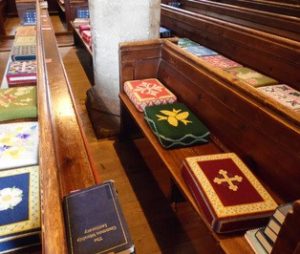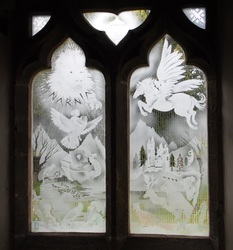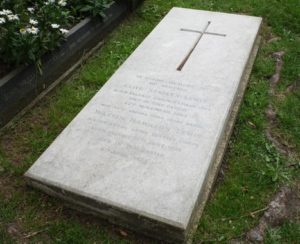Each year we welcome many visitors to Holy Trinity who have come to see where C S Lewis worshipped for over 30 years and where he now lies at rest in the churchyard. Lewis probably started attending the church sometime in 1930. The Kilns’, his home from 1930, is about 10 minutes walk from the church. We know that the first time he took communion since boyhood was at Holy Trinity on Christmas Day 1931.
Lewis had a lifelong dislike of organ music and his preference was therefore to attend the 8 a.m. communion service which was a said-service.

At this service he almost always sat in the same pew – shown here – as close as he could get to the pillar. From here he could observe all the key elements of the service, but be shielded from the view of others in the congregation.
We know that he sometimes attended other services. Probably the most notable was on 15 July 1940 when, having been unwell, he decided to have a lie-in and attend the 11 a.m. service instead. He didn’t get on particularly well with the vicar of that time and found his sermons tedious. This occasion was no exception and Lewis’s mind started to wander. However, this wandering was productive – during the sermon and as he continued to ponder as he walked back to ‘The Kilns’, the concept and outline for ‘The Screwtape Letters’ was almost completely formed in his mind.

Adjacent to ‘The Lewis Pew’ is the Narnia Window. Installed in 1992 as a memorial to a brother and sister associated with the church and who died at the ages of 16 and 2 respectively, the window depicts scenes from Lewis’s much-loved ‘Chronicles of Narnia’. The faces of the three children shown in the window were modelled from children who were in the congregation when the window was designed.

C S Lewis died on 22 November 1963 and his funeral took place just four days later. It was a cold and windy day with flakes of snow in the air. As Lewis had died on the same day as President J F Kennedy had been assassinated, the news of his death was delayed in being made public. Consequently, many of his friends and colleagues were unaware of his passing and his funeral. J R R Tolkien was one of only about 30 people at the funeral. Maybe that is how Lewis would have wanted it. He hated being in the limelight and thought that he would be forgotten five years after his death. He would probably be amazed, bewildered and not a little annoyed at the praise that is now heaped on him and the national acknowledgement of his greatness with a memorial in Poets’ Corner in Westminster Abbey.
A BBC video about Lewis and his life in Headington.
